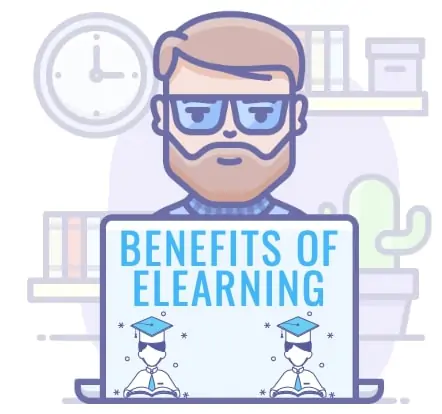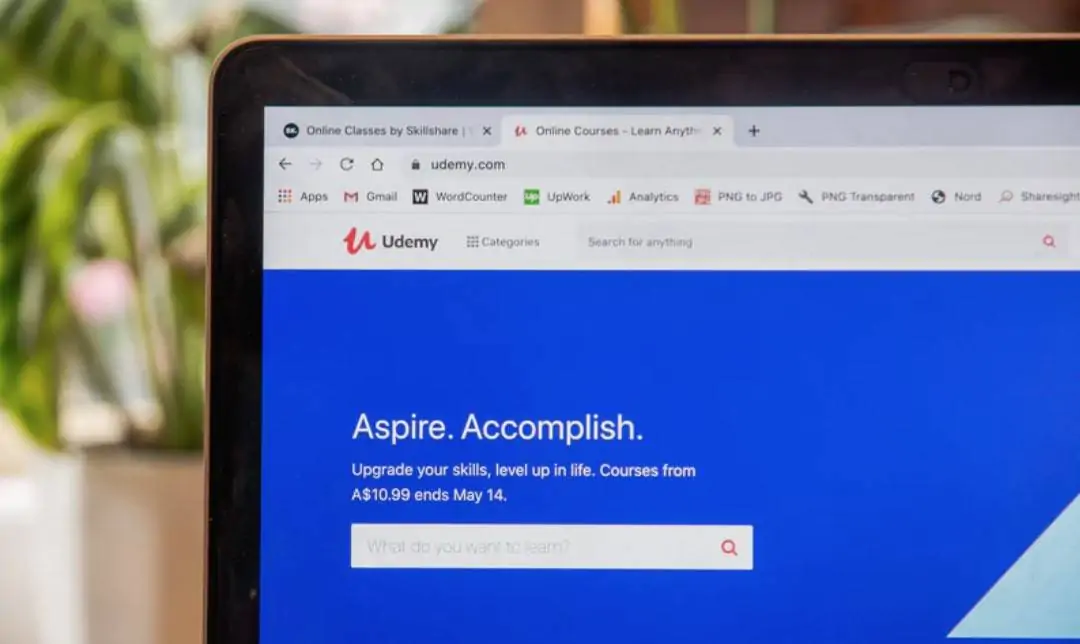23+ Benefits Of eLearning You Should Know


If you are weighing up the benefits of eLearning to see whether or not it’s the right for you, you’re in the right place!
In this guide, I cover many aspects of eLearning from retention of students, affordability of learning, access to world-class teachers, scalability, and even the environmental impact.
Below, you will find various advantages of eLearning that I have researched and have also heard from our readers. Let’s begin!
23+ Benefits Of eLearning You Should Know

1. Accessible Education To The Masses
One of, if not the major benefit of eLearning is that it makes education accessible to almost anyone. Simply, all you need is a stable internet connection and an internet compatible device
If you have these two things, this opens up a global network of classes, lessons, courses, degrees, and training that can be undertaken by any person regardless of gender, race, income, background, or culture.
This access to online learning material allows developing countries, underprivileged communities, independent learners, hobbyists, and job seekers to further their education without the need for a physical classroom.
2. Online Learning Solves Teacher Scarcity

Another incredible advantage of educational websites and eLearning is the ability to leverage specialized and in-demand teachers, professors, and trainers.
As an example, Harvard University’s CS50 Introduction to Computer Science (which is free), has enabled 2.2 million students to get access to world-class professors and education from one of the most prestigious universities in the world.
3. Remote Learning Can Easily Be Scaled
Another advantage of eLearning is that there is no limit to the reach and scale of learning materials. Whether it’s 100 or 1,000,000 students, online courses and LMS can be scaled vertically with no limits, while still delivering great user experience.
Currently, there are dozens of learning platforms such as edX, Coursera, Udemy, and LinkedIn Learning to name a few who utilize this technology. Cloud computing companies like AWS, Azure, and Google Cloud are leading the front in this industry.
4. eLearning Is More Friendly On The Environment

One of the beneficial side effects of eLearning is the small, and in some cases, carbon positive impact on the environment.
As eLearning can be done remotely, this removes cars and public transport off the road as students/ workers don’t need to travel to a campus. It also removes the need for cutting down trees for the printing of textbooks.
While servers are expensive to run and can drain the electricity power grid, many data centers have moved to renewable energy to lower expenses, and in some cases even create more energy than they use.
5. eLearning Is More Affordable
In 2024, it’s not uncommon to hear graduating students who spend $10,000’s, if not more, on their education.
When compared to eLearning, online courses and classes are only a tiny fraction of the price when compared to traditional educational institutions. This is primarily due to the fact that universities/ colleges have high overheads and can’t scale.
Typically, eLearning degrees, courses, training, and classes can range from free, to around $2,000 on the high end. However, in most cases, courses generally cost between $50-$300 for high-quality teaching material. This is hands down one of the main advantages of eLearning!
6. On-Demand Learning Is More Flexible

With the introduction of on-demand video streaming platforms for consuming content, the same is happening in the education industry.
Gone are the days of sitting in a physical classroom for hours on end. Students now have the ability to consume learning material where they want, and when they want.
This typically results in a greater learning experience as it can be easily fitted around busy lifestyles and work.
7. eLearning Is More Consistent
Instead of having a fractured learning experience that is split up between dozens of teachers and lecturers. LMS “Learning Management Systems” and MOOC’s “Massive Open Online Courses” can easily standardize eLearning material which makes for a more consistent learning experience.
Also with the nature of on-demand learning, course material can be recorded and edited until it meets the satisfaction of the teacher and learning platform. This can also result in a higher grade of teaching quality and materials.
8. Ability To Learn On The Go

In recent reports, it is estimated that 50% of all internet traffic is now on mobile and tablet devices. Because of this, many online course providers have created iOS and Android apps to meet the needs of their students and allow for mobile learning.
With many of these platforms, there is also the ability to download entire videos, audio files, quizzes, and lesson notes for traveling, or for those in poor 4G/5G coverage areas.
9. Classes Can Be Taken An Unlimited Amount Of Times
With traditional learning institutions like colleges and universities, you have to pay every time to re-enroll or retake a class. In some cases, this can result in poor student and learning retention and inflated fees.
On the other hand, MOOCs and LMS allow students and workers to retake classes and training lessons and an unlimited amount of times. This typically results in a greater learning experience while also saving money.
10. eLearning Leeds To Increased Satisfaction & Retention

In recent studies, it has been noted that 81% of students have found that eLearning has greatly benefited their grades.
Also, learning institutions that have enabled eLearning capabilities have found a higher retention rate of 35-60%, compared to 8-10% for in-class lessons.
11. Students Get Access To Current Learning Curriculum
As industries are rapidly evolving in a worldwide economy, skills can quickly become outdated and obsolete. This is another great advantage of eLearning as the curriculum can easily be updated with a few clicks of a button.
Once the learning material is updated to current standards and expectations, it can then be shared and be accessible instantly. This allows for eLearning material to be ever-evolving and up to date.
12. eLearning Caters To Individualviduals
While many think of eLearning and online courses as a static learning experience, in many cases, it is the exact opposite.
Instead of just enrolling in a single online class. Students now have the ability to choose dynamic and flexible learning paths that best suits their learning needs and abilities. This could include video lessons, quizzes, live Q&As, and written material to name a few.
13. More Interactive Learning Content

Typically, eLearning consists of on-demand or live video lessons that students can watch in real-time or at a later date.
However, there are also other options such as interactive quizzes, gamification of content, interactive video scenarios, live Q&As, student community threads, virtual reality lessons, audio lessons, and many more.
14. Access To Micro-Niche Content That Is Hard To Find
With physical education institutions, locals are restricted to the courses that they have on offer. Usually, large institutions cater to in-demand and popular skills and learning paths.
However, with eLearning, there really is no limit to what you can learn, regardless of how niche-specific you want to go.
As an example, eLearning provides micro-niches classes for C++ entrepreneur developers, PowerShell VMware training, or even courses specifically for long exposure photography. There really are no limits.
15. Receive Live Feedback From Teachers/ Trainers
One of the biggest critiques of eLearning is that it lacks the face-to-face interaction which helps students/ workers to further develop their learning.
To battle this, many MOOCs now implement daily/ weekly live video Q&As with professors/ teachers, live feedback on submitted work, student boards for advice, and dynamic comment threads.
16. Accrediated Certificates Of Completion Can Be Obtained

Another positive to eLearning is that many platforms provide accrediated certificates of completion which is great for bolstering up a resume and keeping skills relevant.
This also helps job seekers as many large corporations actively look for these accreditations. Some notable MOOCs that provide accrediated certificates include edX, Coursera, PMI, Microsoft Learning Online Program, eCornell, and Kaplan University to name a few.
17. Community Forums & Discussion Boards Help Isolated Students
While many students crave interaction with other students and peers, this is often quite hard with eLearning.
To combat this, many educational websites and course providers now include discussion threads, ZOOM catchups, slack threads, and live feedback for students. This helps to boost student morale while also providing a sense of community.
18. Online Lessons/ Courses Can Be Taken Quickly
Unlike traditional courses that are spread over several days, weeks, or months in bite-sized chunks. It is the complete opposite of eLearning.
Like a normal course, eLearning also incorporates time frames and learning schedules, however, many students tend to fast pace this process as they have the ability of “binge learning”.
19. No Need For Clunky Textbooks

While this may be considered a small benefit, online learning completely removes the necessity for textbooks.
This is primarily due to the fact that many eLearning providers include digital learning notes, power points, references, and eBooks to their students for free.
20. eLearning Is 24/7/365
Living in a culture of instant gratification and access to video streaming websites at any time, the same now applies to eLearning.
While universities, colleges, and schools may close over the summer or winter breaks, this isn’t the case with the online learning industry. Classes, courses, and lessons are available at any time and it never closes.
This is definitely one of the major benefits of eLearning that traditional learning institutions simply can’t compete with.
21. Easy To Measure Results & Performance
Whether you are an independent learner or a business that is using an LMS for internal training. It has never been easier to see an individual or workforces learning progress.
With eLearning platforms, users can get live feedback on interaction, completions, pass/ fail rates, progress, retention, and many more data points. This same process also saves many hours of administration work for businesses.
22. eLearning Is More Adaptable

In the wake of a global pandemic, the eLearning industry has really now shown its strengths and benefits to a global audience. Not to mention the ability to adapt to an ever-evolving environment.
With the power of scale and the reach of the internet, the online education industry has skyrocketed in popularity by over 80% according to Google Trends.
23. eLearning Is More Beneficial For Businesses & Workers
In a recent study, data suggested that businesses were able to save 50-70% of their money when transiting from a face-to-face instructor to eLearning.
Similar studies also found that when employees were taught via eLearning courses, employee retention increased by anywhere from 25-60%.
Conclusion
While eLearning isn’t perfect and still has room for improvement, the benefits such as affordability, access to world-class teachers, scalability, and a global reach to students, seem to far out way the disadvantages.
